Varanasi is the holiest of Indian cities and stands proudly on the banks of the River Ganga (Ganges). The city draws pilgrims from around the world to worship, to meditate but, above all, to bathe. For a Hindu, it is the place to be born and the place to die.
We came here because we couldn’t get out of Delhi into Rajasthan until the weekend and certainly did not want to hang about in the capital. It’s the sort of place that an intrepid traveler is glad to have experienced but will not be in a hurry to revisit. Frankly, it’s a dump.
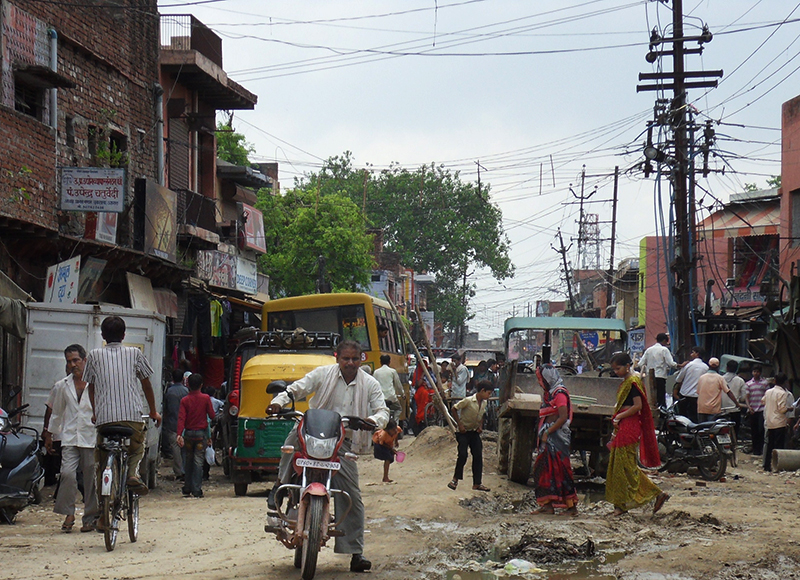 The narrow alleyways of the old town are strewn with a mixture of rubbish and excrement (human and animal) that leaves us tip toeing about and which fills the air with a repugnant aroma that assaults the nostrils in the most unpleasant way. It’s the perfect place to get people out of the habit of picking their noses. The river, as we’ve all heard, is mightily polluted being both the city’s sewer and mortuary. On average, 300 dead bodies a day, in varying stages of decomposition, are thrown into the murky waters. It’s so polluted that even the cholera virus can only survive 3 hours in it against 24 hours in clean water. In an effort to clean up some of the pollution, the authorities introduced flesh eating turtles further downstream to devour the rotting corpses but the turtles have mysteriously disappeared. The imagination runs riot trying to speculate what may have become of them.
The narrow alleyways of the old town are strewn with a mixture of rubbish and excrement (human and animal) that leaves us tip toeing about and which fills the air with a repugnant aroma that assaults the nostrils in the most unpleasant way. It’s the perfect place to get people out of the habit of picking their noses. The river, as we’ve all heard, is mightily polluted being both the city’s sewer and mortuary. On average, 300 dead bodies a day, in varying stages of decomposition, are thrown into the murky waters. It’s so polluted that even the cholera virus can only survive 3 hours in it against 24 hours in clean water. In an effort to clean up some of the pollution, the authorities introduced flesh eating turtles further downstream to devour the rotting corpses but the turtles have mysteriously disappeared. The imagination runs riot trying to speculate what may have become of them.
Varanasi draws its name from two streams that empty into the River Ganga, the Varuna in the north and the Assi, a small trickle, in the south. The Buddha visited in 500BC when it became an important centre for Culture, education, commerce and craftsmanship. It was, and remains, the chief centre of Sanskrit learning in Northern India. Sanskrit, the oldest of the Indo-European languages, is used for Hindu ritual and has been sustained here long after it ceased to be a living language elsewhere.
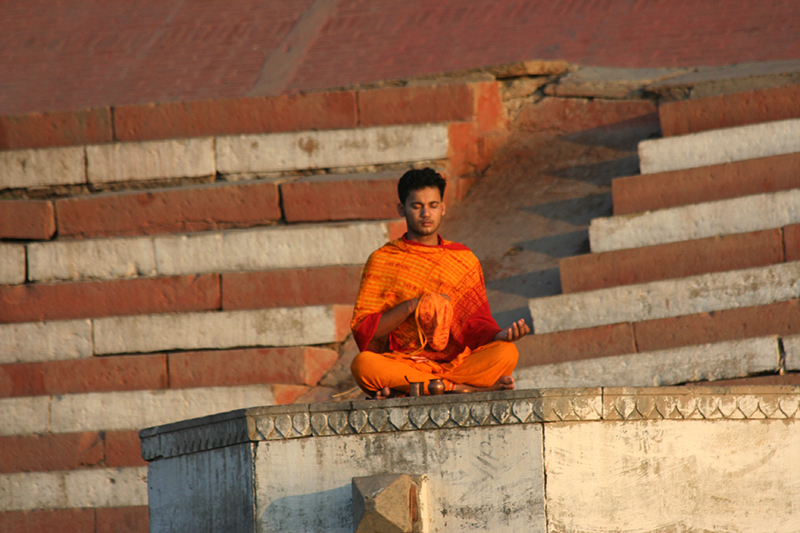 The city attracts well over a million pilgrims every year and has around 50,000 Brahmins, the highest caste, as permanent residents. Anyone dying within the holy city markers is believed to be transported straight to heaven and devout Hindus will often move to Varanasi to end their days and have their ashes scattered in the holy Ganga.
The city attracts well over a million pilgrims every year and has around 50,000 Brahmins, the highest caste, as permanent residents. Anyone dying within the holy city markers is believed to be transported straight to heaven and devout Hindus will often move to Varanasi to end their days and have their ashes scattered in the holy Ganga.
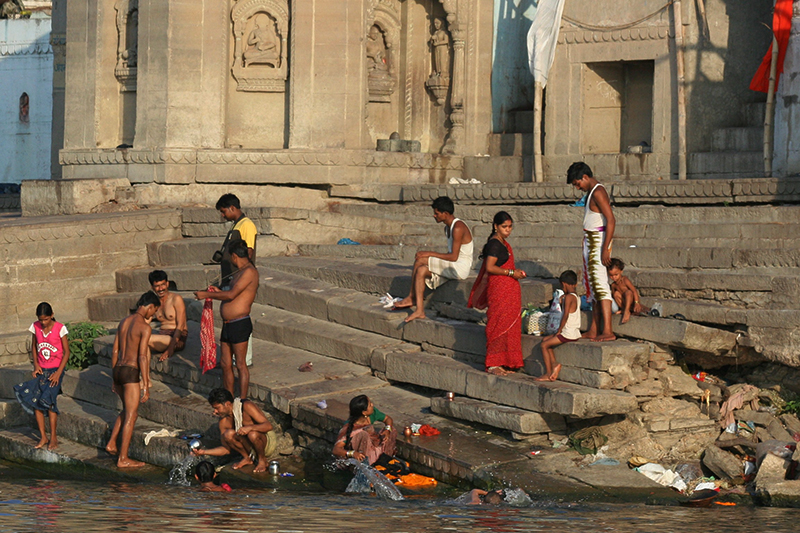 Most activities, such as bathing, prayer and laundry, take place along the river from one of the 365 Ghats (steps), areas along the waterfront that vary in width from about 30 metres to almost 100 metres. At this time of year when the volume of water is at its lowest, most of them have long steps that lead down to the river. The few ghats that don’t have steps are used for cremations, particularly the Manikamika Ghat, the main one, Harishchandra Ghat, and the Jalasayin Ghat. These have banks on which the bodies are burnt before the remains are swept into the river.
Most activities, such as bathing, prayer and laundry, take place along the river from one of the 365 Ghats (steps), areas along the waterfront that vary in width from about 30 metres to almost 100 metres. At this time of year when the volume of water is at its lowest, most of them have long steps that lead down to the river. The few ghats that don’t have steps are used for cremations, particularly the Manikamika Ghat, the main one, Harishchandra Ghat, and the Jalasayin Ghat. These have banks on which the bodies are burnt before the remains are swept into the river.
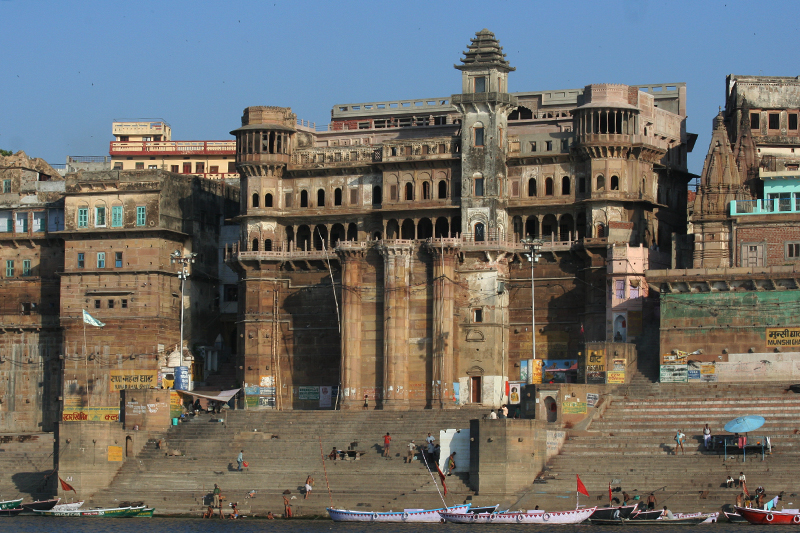 Every ghat has a story or a myth behind it that has religious significance. For example, Dasasvamedha Ghat is known as the ‘place of the ten horse sacrifices’ performed here by Brahma, God of Creation. It is believed that in the age of the gods, when the world was in chaos, Divodasa was appointed King of Krashi by Brahma. He accepted the appointment on condition that all the gods would leave Varanasi. Brahma accepted this condition with one of his own, that Divodasa had to perform a complex ceremony of horse sacrifice without fault. Otherwise the gods would be allowed back into the city. Divodasa performed the ceremony flawlessly and the ghat has now become one of the holiest. Bathing here is regarded as being particularly meritorious.
Every ghat has a story or a myth behind it that has religious significance. For example, Dasasvamedha Ghat is known as the ‘place of the ten horse sacrifices’ performed here by Brahma, God of Creation. It is believed that in the age of the gods, when the world was in chaos, Divodasa was appointed King of Krashi by Brahma. He accepted the appointment on condition that all the gods would leave Varanasi. Brahma accepted this condition with one of his own, that Divodasa had to perform a complex ceremony of horse sacrifice without fault. Otherwise the gods would be allowed back into the city. Divodasa performed the ceremony flawlessly and the ghat has now become one of the holiest. Bathing here is regarded as being particularly meritorious.
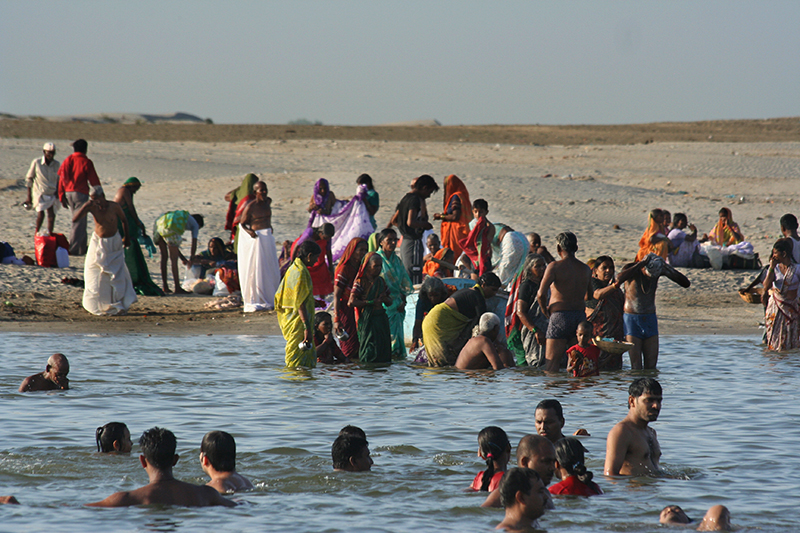 We hired a small boat at dawn to take us along the river to experience the early morning activity. Bathing at dawn, facing the rising sun, is pretty much compulsory for any pilgrim. The men wade into the sludge coloured water, soap themselves from head to foot and disappear beneath the surface. They may then submerse themselves several times more before starting to chant whilst standing in the river up to their waist. They also use a small copper pot to gather and empty water as they recite some holy verses. When all this has been completed satisfactorily, they move to the bank and finish by cleaning their teeth with a finger. We are amazed that the entire Hindu population of Varanasi is not constantly ill from all their river ablutions and rituals. They must have stomachs made from cast iron.
We hired a small boat at dawn to take us along the river to experience the early morning activity. Bathing at dawn, facing the rising sun, is pretty much compulsory for any pilgrim. The men wade into the sludge coloured water, soap themselves from head to foot and disappear beneath the surface. They may then submerse themselves several times more before starting to chant whilst standing in the river up to their waist. They also use a small copper pot to gather and empty water as they recite some holy verses. When all this has been completed satisfactorily, they move to the bank and finish by cleaning their teeth with a finger. We are amazed that the entire Hindu population of Varanasi is not constantly ill from all their river ablutions and rituals. They must have stomachs made from cast iron.
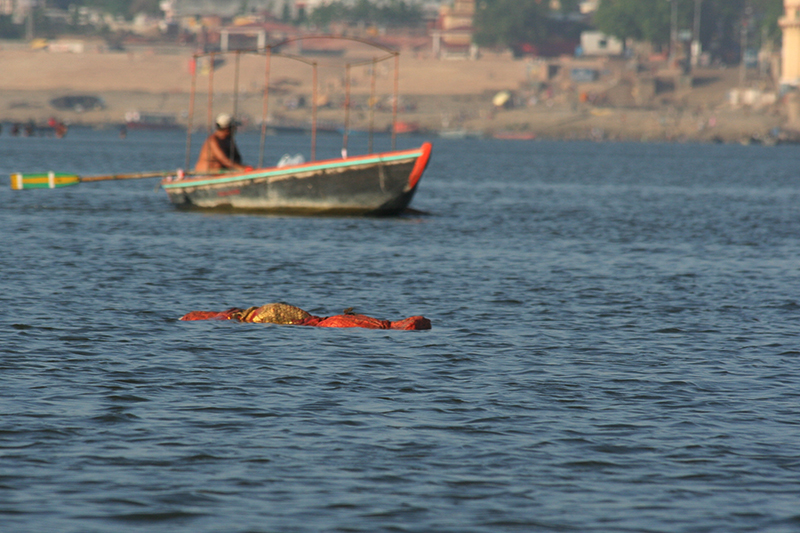 While out in our boat, we came across a body that had been wrapped from head to foot in muslin cloth and placed in the river. It floated past quietly. Not everyone can afford the cost of burning and, while it is supposed to illegal to put whole bodies into the river, the boatman tells us that it is common.
While out in our boat, we came across a body that had been wrapped from head to foot in muslin cloth and placed in the river. It floated past quietly. Not everyone can afford the cost of burning and, while it is supposed to illegal to put whole bodies into the river, the boatman tells us that it is common.
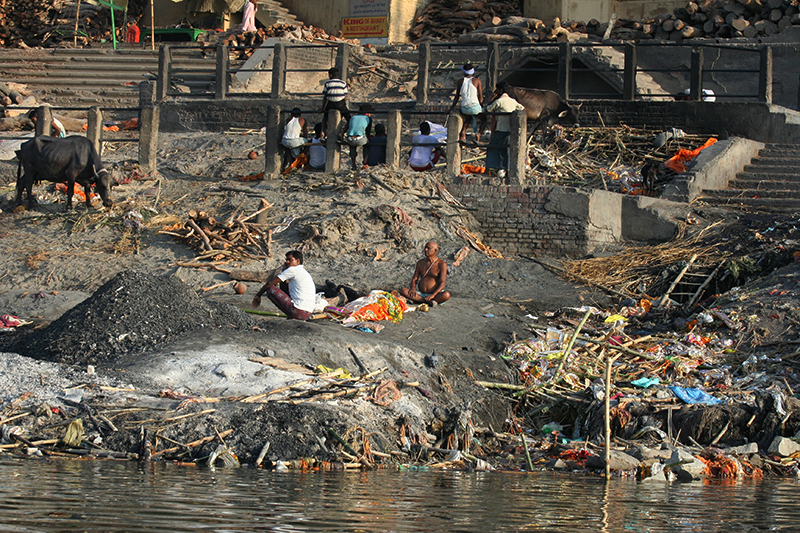 We also see bodies brought down to the water’s edge for cremation. We later talked to a gentleman who works in a house where the old go to await death. He was happy to tell us about it, ‘Learning for burning’ he said, on the basis that we paid him some Rupees (rather a lot it turned out) towards the costs of firewood for the poor. He told us that it takes about 200Kg of wood to burn an average body at a cost of 100 Rupees (US$2) per Kilo. If you can afford it, sandalwood, oils and other sweet smelling materials can be used. It takes between two and three hours for the body to burn but, even then, ribs and hip bones will still remain. Nevertheless, after the wood has burnt out, the ashes and whatever remains of the body are swept into the river.
We also see bodies brought down to the water’s edge for cremation. We later talked to a gentleman who works in a house where the old go to await death. He was happy to tell us about it, ‘Learning for burning’ he said, on the basis that we paid him some Rupees (rather a lot it turned out) towards the costs of firewood for the poor. He told us that it takes about 200Kg of wood to burn an average body at a cost of 100 Rupees (US$2) per Kilo. If you can afford it, sandalwood, oils and other sweet smelling materials can be used. It takes between two and three hours for the body to burn but, even then, ribs and hip bones will still remain. Nevertheless, after the wood has burnt out, the ashes and whatever remains of the body are swept into the river.
Jewelry, watches and gold fillings that have been left on the corpse (because it is considered unlucky to remove them) is recovered by the cremation site workers by dredging the river banks with their hands. They hand it to the boss man who sells it to pay their wages.
Further downstream is the main dhobi (clothes washing) area. There are a series of flat stones just above the waterline on which clothing is scrubbed with soap before being swung overhead and smashed on the stones until clean (as much as anything can be clean having been washed in the dirty Ganga). The clothes are then either hung up to dry or, in rather perverse fashion, laid out on the (filthy) hot steps. I cannot imagine anything coming back clean from this process but, I suppose, the garments might have been imbued with a measure of the holy spirit from the river.
The other main sites in Varanasi are the multitudinous temples and we braved the noxious smells and the piles of rubbish in the congested maze of twisting alleyways to try to get a look. It seemed that we came across an entrance to a temple every couple of minutes but, alas, not being Hindus, we were not allowed inside and not allowed to take photographs either. So we learnt very little and saw even less. This was a pity because the Golden Temple is supposed to be stunning.
We managed to find our way to the main road only by navigating the slimy lanes using the sun and Debbie’s uncanny sense of direction. I have learnt over the last year that, if I think we should go left and Debbie says its right, to follow whatever direction she says because she is invariably correct. Confusion does occasionally happen when Debbie says left when she means right and vice versa: “We go left here,” she says, while holding our her right hand. On foot this isn’t usually a problem but on a bike, I have to be psychic: “right” Might mean that I’m doing alright and should continue straight on or, it might mean turn right or, it might mean turn left. I guess correctly, on average, one time in every three.
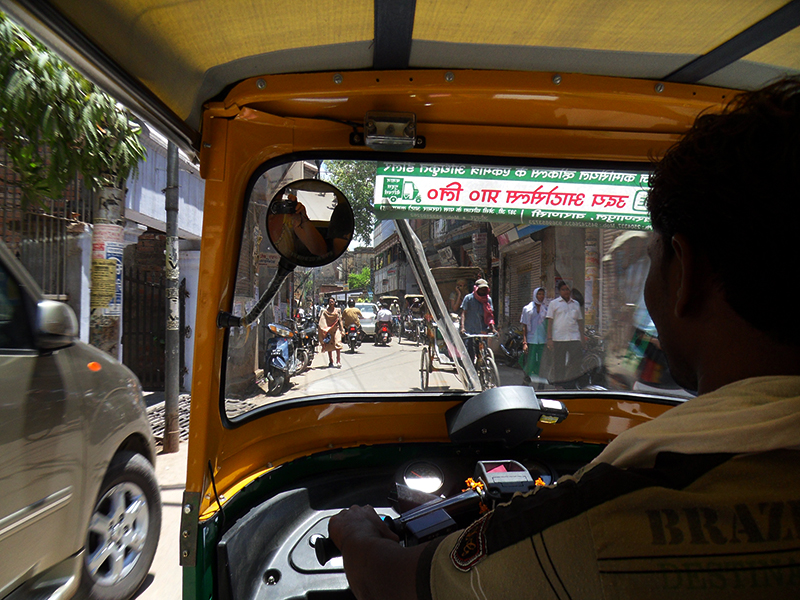 Back on the main road through Varanasi, space is at a premium. Trucks, cars, motorised and unmotorised Rickshaws, motorcyclists, cyclists and pedestrians fight for space. Despite a government poster campaign that advises ‘Traffic rules are like promises, they should always be kept”, traffic goes wherever it chooses. I think the rule is that you have the right to occupy the space you are in and any other available space that you can find no matter in what part of the road that space may be. Blowing the horn is also a particular requirement but, as everyone does it all the time, mostly for no particular reason, no one takes any notice. The result is a noisy, chaotic mess in which the traffic moves sluggishly. While we were prepared to take to the roads in Vietnam and Cambodia, I wouldn’t care to do it here.
Back on the main road through Varanasi, space is at a premium. Trucks, cars, motorised and unmotorised Rickshaws, motorcyclists, cyclists and pedestrians fight for space. Despite a government poster campaign that advises ‘Traffic rules are like promises, they should always be kept”, traffic goes wherever it chooses. I think the rule is that you have the right to occupy the space you are in and any other available space that you can find no matter in what part of the road that space may be. Blowing the horn is also a particular requirement but, as everyone does it all the time, mostly for no particular reason, no one takes any notice. The result is a noisy, chaotic mess in which the traffic moves sluggishly. While we were prepared to take to the roads in Vietnam and Cambodia, I wouldn’t care to do it here.
But there isn’t much that I care to do in Varanasi. It’s not the sort of place for a westerner to enjoy especially one who has got used to the joys of sanitation. Having a hotel room in which to take sanctuary that has hot water and aircon (forget about WiFi) is a great help provided both work (they didn’t in ours); otherwise the poor visitor will feel that there is no escape from the heat and the filth. I am glad we came but I don’t want to go again.

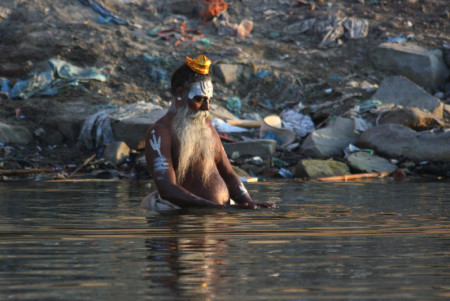
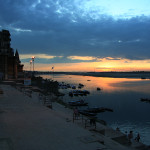
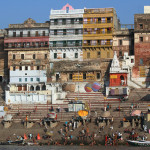
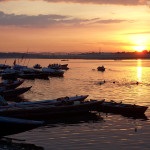
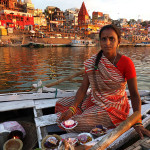
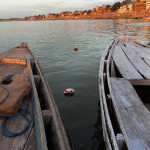
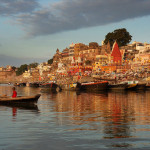
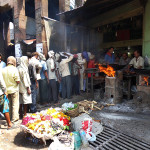
No comments yet.